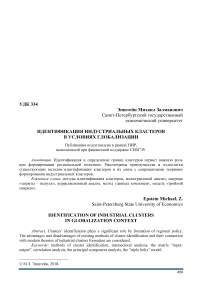Идентификация индустриальных кластеров в условиях глобализации
Автор: Эпштейн Михаил Залманович
Журнал: Вестник факультета управления СПбГЭУ @vfu-spgeu
Рубрика: Международные аспекты развития инновационных кластеров
Статья в выпуске: 3-1, 2018 года.
Бесплатный доступ
Идентификация и определение границ кластеров играют важную роль при формировании региональной политики. Рассмотрены преимущества и недостатки существующих методов идентификации кластеров и их связь с современными теориями формирования индустриальных кластеров.
Методы идентификация кластеров, межотраслевой анализ, матрица "затраты - выпуск", корреляционный анализ, метод главных компонент, модель "тройной спирали"
Короткий адрес: https://sciup.org/148319633
IDR: 148319633
Список литературы Идентификация индустриальных кластеров в условиях глобализации
- Миркин Б.Г. Проблема группового выбора/Б.Г. Миркин. М.: Наука, 1974. 256 с.
- Портер М. Международная конкуренция. Конкурентные преимущества стран/М. Портер. М.: Междунар. отношения. 1993. 1470 с.
- Business Clusters in the U.K -A First Assessment/R. Botham, H. Gibson, R. Martin, B. Moore//A Report for the Department of Trade and Industry, A Consortium led by Trends Business Research. 2001.
- Campbell, J. A Structural Approach to Growth Pole Theory/J. Campbell//In Problems of Slow Growth and Stagnant Areas in Developed Countries. 1972. P. 59-68.
- Czamanski, S. Identification of industrial clusters and complexes: a comparison of methods and findings/S. Czamanski, L. Augusto de Q. Ablas//Urban Studies. 1979. Vol. 16. Р. 61-80.
- Engel, J.S. Global networks of clusters of innovation: Accelerating the innovation process/J.S. Engel//Business Horizons. 2009. Vol. 52, issue 5. P. 493-503.
- Feser, E.J., Bergman, E.M. National industry cluster templates: А framework for applied regional cluster analysis/E.J. Feser, E.M. Bergman//Regional Studies. 2000. Vol. 34.1. Р. 1-19.
- Feser, E.J., Luger, M.I. Cluster analysis as a mode of inquiry: It's use in science and technology policymaking in North Carolina/E.J. Feser, M.I. Luger//European Planning Studies. 2003. Vol. 11. №1. Р. 11-24.
- Hill, E.W., Brennan, J.F. A Methodology for identifying the drivers of industrial clusters: the foundation of regional competitive advantage/E.W. Hill, J.F. Brennan//Economic Development Quarterly. 2000. Vol. 14. Р. 67-96.
- Hofe, R. Whither or Not Industrial Cluster: Conclusions or Confusions?/R. vom Hofe., K. Chen//The Industrial Geographer. 2006. Vol. 4. №1. P. 2-28.
- O'Huallachdin, B. The Identification of Industrial Complexes/B. O'Huallachdin//Analyze of the Association of American Geographers. 1984. Vol. 73. №3. P. 420-436.
- O'Huallachdin, B. Regional growth in a knowledge-based economy/B. O'Huallachdin//International Regional Science Review. 2007. Vol. 30. №3. P. 221-248.
- Peters, D. Revisiting Industry Cluster Theory and Method for Use in Public Policy: An Example Identifying Supplier-based Clusters in Missouri/D. Peters//The Mid-Continent Regional Science Association, 35th. Annual Meeting, Madison, Wisconsin. 2004.
- Roepke, H.D. A new approach to the identification of industrial complexes using input-output data/H.D. Roepke, D. Adams, R. Wiseman//Journal of Regional Science. 1974. No.14.1. Р. 15-29.
- Trifonova N., Klementovichus Y., Borovskaia I., Proshkina A., Vardanyan I. Innovation Clusters in Petrochemical Industry in Asia-Pacific Zone//Proceedings of the International Conference on Transformations and Innovations in Management (ICTIM-17). Series Advances in Economics, Business and Management Research (AEBMR).2017. Vol. 37. P. 630-642.
- Zeller, C. Clustering in Biotech: A Recipe for Success? Spatial Patterns for Growth of Biotechnology in Munich, Rhineland and Hamburg/C. Zeller//Small Business Economics. 2001. Vol. 17 (1/2). P. 123-141.


